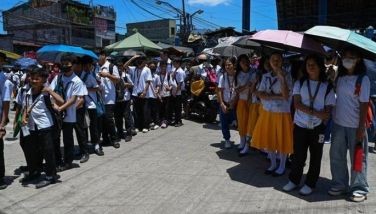Next president should be like seaworthy ship - FVR
MANILA, Philippines - Former President Fidel Ramos said yesterday that the country’s next President must be like a ship that is seaworthy, well navigated and can avoid storms.
He also emphasized that the next president and other elected officials who should be elected are the ones who did not destroy the reforms undertaken for good government.
“We are all on board the same ship called the Republic of the Philippines. It is the only ship that we have and you are on board so we must make sure that the ship is seaworthy. Don’t put any holes. Many people are putting holes right now after we repaired the leaks,” Ramos said in a chance interview at the annual Veterans Day at the Manila American Cemetery and Memorial in Taguig City.
He said electing candidates from the top all the way down to the local is not an instant decision to be made but must be well-studied and there cannot be just one color or one person.
Ramos has not announced the presidential candidate he will support in next year’s election but he said the candidate should possess 4Ms – makatao, makabayan, makakalikasan and maka-Diyos. (For people, country, nature and God).
“Make sure it is seaworthy, it is well navigated, it can avoid the storms, the rocks and other obstacles and be sure it is also competitive. It should move faster than the others in our neighborhood,” he added.
Meanwhile, Sen. Miriam Defensor-Santiago recommended yesterday that climate change adaptation initiatives should be included in presidential debates.
“As we face the 2010 presidential elections, we have to recognize that one of the most urgent policy needs in the Philippines is the identification of the areas most vulnerable to climate change,” she said. “Hence, I respectfully challenge our presidential candidates, to identify appropriate courses of action to address the adverse effects of climate change.”
In a privilege speech before the Senate, Santiago said the Philippines had been identified as one of the most disaster prone countries in the world, because of its geographical location.
Climate change will influence Philippine weather in terms of changes in temperature, rainfall, and tropical cyclone activity. In turn, this impacts such sectors as agriculture, forestry, and water resources.
Citing a climate change vulnerability map by the Economy and Environment Program for Southeast Asia (EEPSEA), Santiago said that the Philippines is a “hotspot” in Southeast Asia.
“Practically all the regions in our country are vulnerable to climate-related hazards, namely, tropical cyclones, floods, landslides, droughts, and sea level rise,” she said. “The triple typhoons and accompanying floods that wreaked havoc in the Philippines recently are clear manifestations of the high vulnerability of the country to climate change.”
Santiago said the EEPSEA vulnerability ranking of provinces for the Philippines shows that Metro Manila (badly hit by storm “Ondoy”) and Benguet (ravaged by typhoon “Pepeng”) rank first and second, respectively, in vulnerability to climate change.
“The main challenge to the next president is transparency, efficiency, and equity in the use of these funds. The threat from climate change is real. Therefore, we need a president determined to make a serious and concerted effort to prepare for climate-related disasters ahead of us,” she added. – Christina Mendez
- Latest
- Trending






























